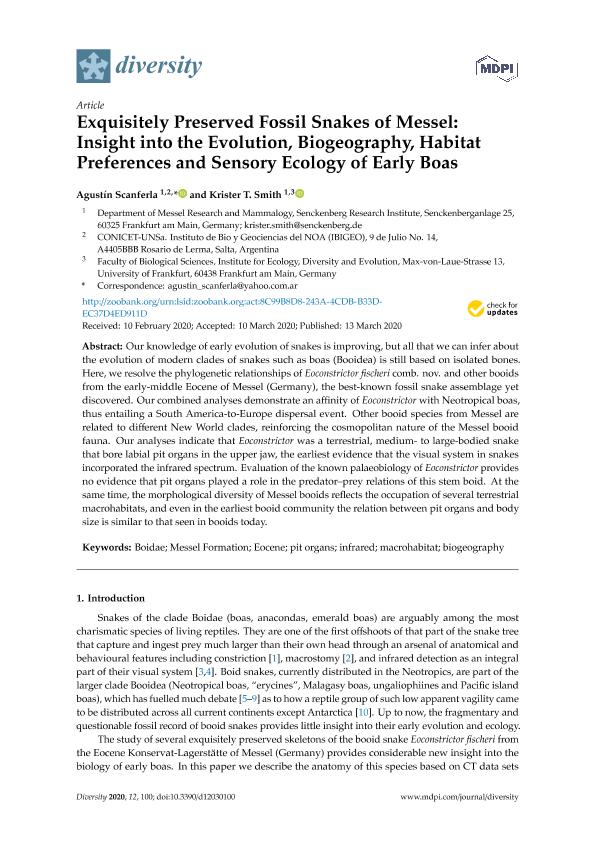Mostrar el registro sencillo del ítem
dc.contributor.author
Scanferla, Carlos Agustín

dc.contributor.author
Smith, Krister T.
dc.date.available
2021-10-29T04:34:46Z
dc.date.issued
2020-03-13
dc.identifier.citation
Scanferla, Carlos Agustín; Smith, Krister T.; Exquisitely preserved fossil snakes of messel: Insight into the evolution, biogeography, habitat preferences and sensory ecology of early boas; Multidisciplinary Digital Publishing Institute; Diversity; 12; 3; 13-3-2020; 1-16
dc.identifier.uri
http://hdl.handle.net/11336/145425
dc.description.abstract
Our knowledge of early evolution of snakes is improving, but all that we can infer about the evolution of modern clades of snakes such as boas (Booidea) is still based on isolated bones. Here, we resolve the phylogenetic relationships of Eoconstrictor fischeri comb. nov. and other booids from the early-middle Eocene of Messel (Germany), the best-known fossil snake assemblage yet discovered. Our combined analyses demonstrate an affinity of Eoconstrictor with Neotropical boas, thus entailing a South America-to-Europe dispersal event. Other booid species from Messel are related to different New World clades, reinforcing the cosmopolitan nature of the Messel booid fauna. Our analyses indicate that Eoconstrictor was a terrestrial, medium- to large-bodied snake that bore labial pit organs in the upper jaw, the earliest evidence that the visual system in snakes incorporated the infrared spectrum. Evaluation of the known palaeobiology of Eoconstrictor provides no evidence that pit organs played a role in the predator–prey relations of this stem boid. At the same time, the morphological diversity of Messel booids reflects the occupation of several terrestrial macrohabitats, and even in the earliest booid community the relation between pit organs and body size is similar to that seen in booids today
dc.format
application/pdf
dc.language.iso
eng
dc.publisher
Multidisciplinary Digital Publishing Institute
dc.rights
info:eu-repo/semantics/openAccess
dc.rights.uri
https://creativecommons.org/licenses/by/2.5/ar/
dc.subject
Boidae
dc.subject
Messel Formation
dc.subject
Infrared
dc.subject
Biogeography
dc.subject
Eocene
dc.subject
Pit organs
dc.subject
Macrohabitat
dc.subject.classification
Paleontología

dc.subject.classification
Ciencias de la Tierra y relacionadas con el Medio Ambiente

dc.subject.classification
CIENCIAS NATURALES Y EXACTAS

dc.title
Exquisitely preserved fossil snakes of messel: Insight into the evolution, biogeography, habitat preferences and sensory ecology of early boas
dc.type
info:eu-repo/semantics/article
dc.type
info:ar-repo/semantics/artículo
dc.type
info:eu-repo/semantics/publishedVersion
dc.date.updated
2021-09-07T13:57:19Z
dc.identifier.eissn
1424-2818
dc.journal.volume
12
dc.journal.number
3
dc.journal.pagination
1-16
dc.journal.pais
Suiza

dc.journal.ciudad
Basilea
dc.description.fil
Fil: Scanferla, Carlos Agustín. Consejo Nacional de Investigaciones Científicas y Técnicas. Centro Científico Tecnológico Conicet - Salta. Instituto de Bio y Geociencias del NOA. Universidad Nacional de Salta. Facultad de Ciencias Naturales. Museo de Ciencias Naturales. Instituto de Bio y Geociencias del NOA; Argentina. Senckenberg Research Institute; Alemania
dc.description.fil
Fil: Smith, Krister T.. Senckenberg Research Institute; Alemania. Goethe Universitat Frankfurt; Alemania
dc.journal.title
Diversity
dc.relation.alternativeid
info:eu-repo/semantics/altIdentifier/url/https://www.mdpi.com/1424-2818/12/3/100
dc.relation.alternativeid
info:eu-repo/semantics/altIdentifier/doi/http://dx.doi.org/10.3390/d12030100
Archivos asociados
